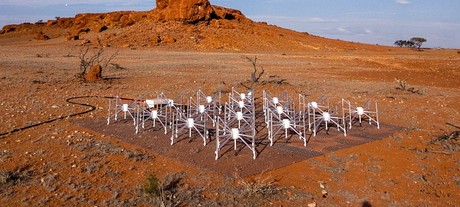Dipoles in the desert

New, programmable receiver technology has replaced a pioneering radio telescope’s ageing, custom-built systems.
The Murchison Widefield Array (MWA) is a large-scale radio telescope run by a consortium of 21 institutions from six different countries, including Australia, Canada, India, Japan, New Zealand and the United States of America. The array is located in the Murchison region of outback Western Australia due to the area’s extremely low population density, which contributes to a superbly radio-quiet environment that is perfect for listening to the skies.
The MWA is capable of a wide range of science investigations, with three key objectives:
- Detection and characterisation of three-dimensional brightness temperature fluctuations in the 21 cm line of neutral hydrogen;
- Solar imaging and remote sensing of the inner heliosphere; and
- High-sensitivity exploration of the variable radio sky.
The Epoch of Reionisation (EoR) is the period in the dawn of the universe, billions of years ago, during which the predominantly neutral intergalactic medium was ionised by the emergence of the first stars. One of the goals of the MWA is to detect the presence of the large ionised bubbles that formed during this period. The MWA is a great testbed to demonstrate the techniques involved with subtracting the bright radio foregrounds in order to see the obscure hydrogen line in the background.
Radio emission from our Milky Way galaxy and from extragalactic sources can obscure EoR observations, but it also makes an interesting scientific target in itself. This resulted in the ‘galactic and extragalactic All-sky MWA’ (GLEAM) survey, a catalogue of 300,000 galaxies over the full Southern Hemisphere sky below 10° declination. This survey was compiled using MWA data and is one of the largest radio surveys of the sky ever assembled.
The ability of the MWA to quickly map the sky makes it invaluable for finding rare and faint events as they happen. The MWA has a time resolution in the nanosecond range, making it an excellent tool to study objects such as pulsars and search for fast transient events.
Antenna system design
The MWA uses 4096 dual-polarisation dipole antennas optimised for the 80–300 MHz frequency range, arranged as 256 tiles, with each tile being a 4 x 4 array of dipoles. These small, distributed antennas work together as a single entity, as if they were a single large-dish receiver.
The original 32-tile MWA prototype has expanded to 256 tiles which can now be found scattered around the Murchison Radio Observatory. The array is split into two subconfigurations — a compact configuration which uses 128 tiles from in and around the telescope’s core, and an extended array made up of the furthest reaching tiles, with a separation distance up to 5 km.
The closely packed antennas of the compact configuration are best for observing large-scale sky structures (such as the EoR), whereas the extended array greatly increases the telescope’s ability to resolve small-scale structures such as individual galaxies.

Currently, the telescopes’ back-end capabilities allow only up to 128 tiles (one configuration) to be connected at any time.
A receiver system is used to perform digitisation and preprocessing of signal data before the information is correlated together. This includes channelisation — selecting only the frequency bands that are of interest — before the data is sent downstream for further processing.
Processing system design
With the eventual goal of correlating data from all 256 tiles together, the MWA required upgrades to its data processing technology. Replacing the custom-built receivers with COTS components that could still be tailored to the specifications was an important requirement, to remove obsolescence in the new system.
This led to the adoption of the NI platform, and the development of an NI Controller for FlexRIO to act like a current receiver, performing both digitisation and channelisation of large volumes of signal data. The ability to program the FlexRIO’s onboard FPGA quickly and efficiently with LabVIEW is a key advantage that has been leveraged in order to expand the MWA.
These standards-based interfaces and COTS components have reduced system development time, allowed for the expansion of the array and improved the quality of the received sky signals.
The NI hardware has been instrumental in developing state-of-the-art methods to perform incredible science, and the flexibility of FPGA programming in LabVIEW has enabled the opportunity for more growth in the future.
Customised rugged tech shaping the next era of defence comms
Rugged computing platforms are becoming central to how armed forces protect communication...
A guide to aquatic survival this summer
While most Australians are planning aquatic adventures this summer, less than a third are...
Maher Terminals enhancing operations with private wireless
Maher Terminals chose the Nokia Edge platform because it needed a secure, reliable,...




